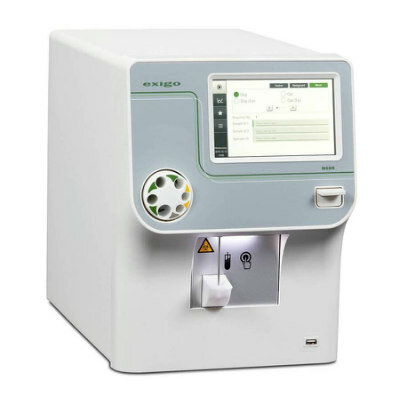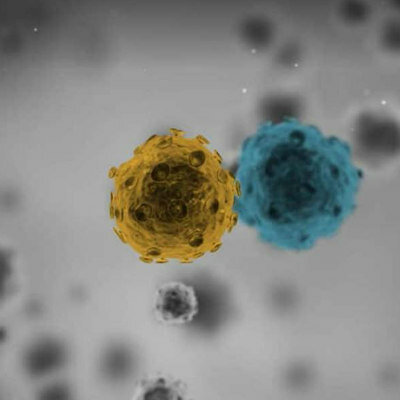Use of Cell-free DNA Liquid Biopsy to Predict Glioblastoma Progression
|
By LabMedica International staff writers Posted on 11 Nov 2019 |

Image: A liquid biopsy blood test that measures the amount of cell-free DNA (cfDNA) in the bloodstream correlates with how patients will progress after they are diagnosed with glioblastoma (Photo courtesy of University of Pennsylvania School of Medicine).
Cancer researchers have demonstrated the potential clinical utility of liquid biopsy to measure plasma cell-free DNA (cfDNA) in patients with newly diagnosed glioblastoma in order to predict the progression of the disease.
Glioblastoma (GBM) is the most common primary tumor of the central nervous system and is almost always fatal. The aggressive invasion of glioblastoma cells into the surrounding normal brain makes complete surgical removal impossible, significantly increases resistance to the standard therapy regimen, and virtually assures tumor recurrence. Treatment of glioblastoma usually comprises surgical removal of the tumor followed by radiation treatment and chemotherapy using the drug temozolomide (TMZ). These treatments usually fail, mainly due to the presence of a cell subpopulation called glioma stem cells (GSCs), which are resistant to radiation and chemotherapy and capable of self-renewal and tumor generation.
As part of a program to develop methods for predicting the progression of GBM, investigators at the University of Pennsylvania School of Medicine (Philadelphia, USA) sought to determine the prognostic impact of plasma cfDNA as well as its role as a surrogate measure of tumor burden and as the subject for next-generation sequencing (NGS).
For this study, the investigators evaluated 42 patients with newly diagnosed GBM. Plasma cfDNA was quantified at baseline prior to initial tumor resection and longitudinally during chemoradiotherapy. Plasma cfDNA was assessed for its association with progression-free survival (PFS) and overall survival (OS), correlated with radiographic tumor burden, and subjected to a targeted NGS panel.
Results revealed that prior to initial surgery, GBM patients had higher plasma cfDNA concentrations than age-matched healthy controls. Plasma cfDNA concentration was correlated with radiographic tumor burden on patients' first post-radiation magnetic resonance imaging scan and tended to rise prior to or concurrently with radiographic tumor progression. Preoperative plasma cfDNA concentration above the mean was associated with inferior PFS. Thus the 28 patients with lowest pre-surgery concentrations of cfDNA - defined as cfDNA that was below the average of the total group - had almost double the length of progression free survival (median 9.5 months) compared with the 14 patients with highest concentrations (median 4.9 months).
Analysis of cfDNA samples from 20 patients by liquid biopsy detected at least one mutation in 11 patients, and all of those mutations differed from those detected in analysis of each patient's solid tumor biopsy.
"Doctors have begun using liquid biopsies more frequently to monitor certain cancers - particularly lung cancer - in recent years as research has shown their effectiveness in other disease sites. But until now, there has been little focus on the clinical utility of liquid biopsy in brain tumors," said senior author Dr. Erica L. Carpenter, assistant professor of medicine at the University of Pennsylvania School of Medicine.
The study was published in the October 30, 2019, online edition of the journal Clinical Cancer Research.
Related Links:
University of Pennsylvania School of Medicine
Glioblastoma (GBM) is the most common primary tumor of the central nervous system and is almost always fatal. The aggressive invasion of glioblastoma cells into the surrounding normal brain makes complete surgical removal impossible, significantly increases resistance to the standard therapy regimen, and virtually assures tumor recurrence. Treatment of glioblastoma usually comprises surgical removal of the tumor followed by radiation treatment and chemotherapy using the drug temozolomide (TMZ). These treatments usually fail, mainly due to the presence of a cell subpopulation called glioma stem cells (GSCs), which are resistant to radiation and chemotherapy and capable of self-renewal and tumor generation.
As part of a program to develop methods for predicting the progression of GBM, investigators at the University of Pennsylvania School of Medicine (Philadelphia, USA) sought to determine the prognostic impact of plasma cfDNA as well as its role as a surrogate measure of tumor burden and as the subject for next-generation sequencing (NGS).
For this study, the investigators evaluated 42 patients with newly diagnosed GBM. Plasma cfDNA was quantified at baseline prior to initial tumor resection and longitudinally during chemoradiotherapy. Plasma cfDNA was assessed for its association with progression-free survival (PFS) and overall survival (OS), correlated with radiographic tumor burden, and subjected to a targeted NGS panel.
Results revealed that prior to initial surgery, GBM patients had higher plasma cfDNA concentrations than age-matched healthy controls. Plasma cfDNA concentration was correlated with radiographic tumor burden on patients' first post-radiation magnetic resonance imaging scan and tended to rise prior to or concurrently with radiographic tumor progression. Preoperative plasma cfDNA concentration above the mean was associated with inferior PFS. Thus the 28 patients with lowest pre-surgery concentrations of cfDNA - defined as cfDNA that was below the average of the total group - had almost double the length of progression free survival (median 9.5 months) compared with the 14 patients with highest concentrations (median 4.9 months).
Analysis of cfDNA samples from 20 patients by liquid biopsy detected at least one mutation in 11 patients, and all of those mutations differed from those detected in analysis of each patient's solid tumor biopsy.
"Doctors have begun using liquid biopsies more frequently to monitor certain cancers - particularly lung cancer - in recent years as research has shown their effectiveness in other disease sites. But until now, there has been little focus on the clinical utility of liquid biopsy in brain tumors," said senior author Dr. Erica L. Carpenter, assistant professor of medicine at the University of Pennsylvania School of Medicine.
The study was published in the October 30, 2019, online edition of the journal Clinical Cancer Research.
Related Links:
University of Pennsylvania School of Medicine
Latest Molecular Diagnostics News
- New Biomarker Panel to Enable Early Detection of Pancreatic Cancer
- Ultrarapid Whole Genome Sequencing for Neonatal and Pediatric Patients Delivers Results In 48 Hours
- AI-Enabled Blood Test Demonstrates Diagnostic, Prognostic and Predictive Utility Across Cancer Continuum
- DNA Methylation Signatures of Aging Could Help Assess Mortality Risk
- Molecular Diagnostics System Provides Lab-Quality Results at POC
- Cellular Signature Identifies Patients with Treatment Resistant Prostate Tumors
- MCED Could Be Valuable Supplement to Traditional Cancer Screening Approaches
- Newly-Cleared Technology a Game Changer for Diagnosis of Lyme Disease
- Innovative Liquid Biopsy Test Uses RNA to Detect Early-Stage Cancer
- Rapid Tests for Chagas Disease Improves Diagnostic Access
- Simple Blood Test to Predict Alzheimer’s Clinical Progression in Earliest Stages
- Saliva Test Could Identify People Genetically Susceptible to Type 2 Diabetes
- Pioneering Analyzer with Advanced Biochip Technology Sets New Standard in Lab Diagnostics
- RNA-Seq Based Diagnostic Test Enhances Diagnostic Accuracy of Pediatric Leukemia
- New Technique for Measuring Acidic Glycan in Blood Simplifies Schizophrenia Diagnosis
- Injury Molecular Fingerprint Enables Real-Time Diagnostics for On-Site Treatment
Channels
Clinical Chemistry
view channel
New Clinical Chemistry Analyzer Designed to Meet Growing Demands of Modern Labs
A new clinical chemistry analyzer is designed to provide outstanding performance and maximum efficiency, without compromising affordability, to meet the growing demands of modern laboratories.... Read more
New Reference Measurement Procedure Standardizes Nucleic Acid Amplification Test Results
Nucleic acid amplification tests (NAATs) play a key role in diagnosing a wide range of infectious diseases. These tests are generally known for their high sensitivity and specificity, and they can be developed... Read moreHematology
view channel
Disposable Cartridge-Based Test Delivers Rapid and Accurate CBC Results
Complete Blood Count (CBC) is one of the most commonly ordered lab tests, crucial for diagnosing diseases, monitoring therapies, and conducting routine health screenings. However, more than 90% of physician... Read more
First Point-of-Care Heparin Monitoring Test Provides Results in Under 15 Minutes
Heparin dosing requires careful management to avoid both bleeding and clotting complications. In high-risk situations like extracorporeal membrane oxygenation (ECMO), mortality rates can reach about 50%,... Read moreImmunology
view channel
Evolutionary Clinical Trial to Identify Novel Biomarker-Driven Therapies for Metastatic Breast Cancer
Metastatic breast cancer, which occurs when cancer spreads from the breast to other parts of the body, is one of the most difficult cancers to treat. Nearly 90% of patients with metastatic cancer will... Read more
Groundbreaking Lateral Flow Test Quantifies Nucleosomes in Whole Venous Blood in Minutes
Diagnosing immune disruptions quickly and accurately is crucial in conditions such as sepsis, where timely intervention is critical for patient survival. Traditional testing methods can be slow, expensive,... Read moreMicrobiology
view channel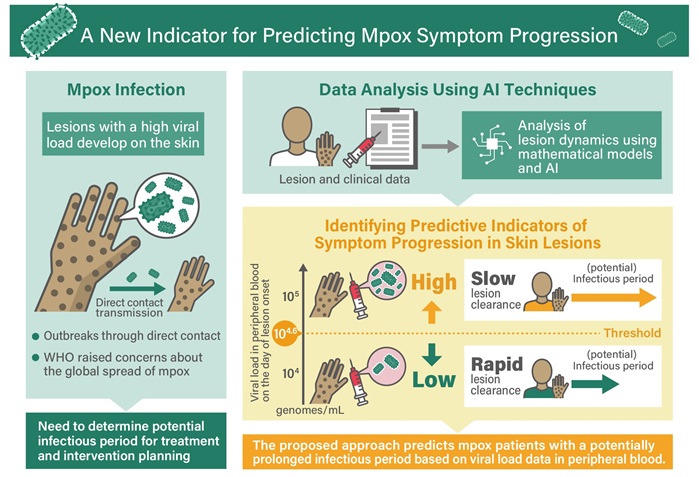
Viral Load Tests Can Help Predict Mpox Severity
Mpox is a viral infection that causes flu-like symptoms and a characteristic rash, which evolves significantly over time and varies between patients. The disease spreads mainly through direct contact with... Read more
Gut Microbiota Analysis Enables Early and Non-Invasive Detection of Gestational Diabetes
Gestational diabetes mellitus is a common metabolic disorder marked by abnormal glucose metabolism during pregnancy, typically emerging in the mid to late stages. It significantly heightens the risk of... Read morePathology
view channel
AI Accurately Predicts Genetic Mutations from Routine Pathology Slides for Faster Cancer Care
Current cancer treatment decisions are often guided by genetic testing, which can be expensive, time-consuming, and not always available at leading hospitals. For patients with lung adenocarcinoma, a critical... Read more
AI Tool Enhances Interpretation of Tissue Samples by Pathologists
Malignant melanoma, a form of skin cancer, is diagnosed by pathologists based on tissue samples. A crucial aspect of this process is estimating the presence of tumor-infiltrating lymphocytes (TILs), immune... Read more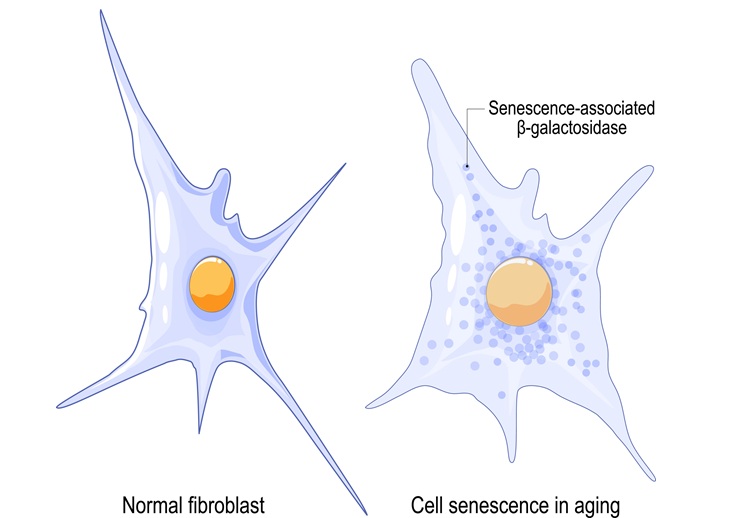
AI-Assisted Technique Tracks Cells Damaged from Injury, Aging and Disease
Senescent cells, which stop growing and reproducing due to injury, aging, or disease, play a critical role in wound repair and aging-related diseases like cancer and heart disease. These cells, however,... Read more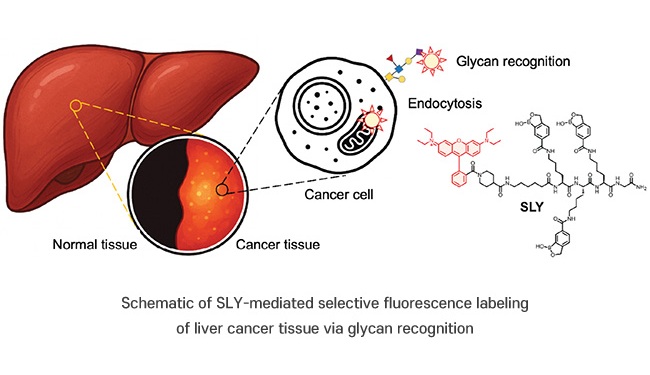
Novel Fluorescent Probe Shows Potential in Precision Cancer Diagnostics and Fluorescence-Guided Surgery
Hepatocellular carcinoma (HCC), a common type of liver cancer, is difficult to diagnose early and accurately due to the limitations of current diagnostic methods. Glycans, carbohydrate structures present... Read moreTechnology
view channel
Multifunctional Nanomaterial Simultaneously Performs Cancer Diagnosis, Treatment, and Immune Activation
Cancer treatments, including surgery, radiation therapy, and chemotherapy, have significant limitations. These treatments not only target cancerous areas but also damage healthy tissues, causing side effects... Read more
Ultra-Sensitive Biosensor Based on Light and AI Enables Early Cancer Diagnosis
Cancer diagnosis is often delayed due to the difficulty in detecting early-stage cancer markers. In particular, the concentration of methylated DNA in the bloodstream during the early stages of cancer... Read moreIndustry
view channel
2025 COMPAMED Innovation Forum Highlights Pioneering Work in Cancer Diagnostics
Cancer cases are among the biggest challenges faced by global healthcare systems. The incidence has risen in recent decades, not least on account of demographic change and escalating risk factors.... Read more
Quanterix Completes Acquisition of Akoya Biosciences
Quanterix Corporation (Billerica, MA, USA) has completed its previously announced acquisition of Akoya Biosciences (Marlborough, MA, USA), paving the way for the creation of the first integrated solution... Read more
Lunit and Microsoft Collaborate to Advance AI-Driven Cancer Diagnosis
Lunit (Seoul, South Korea) and Microsoft (Redmond, WA, USA) have entered into a collaboration to accelerate the delivery of artificial intelligence (AI)-powered healthcare solutions. In conjunction with... Read more




